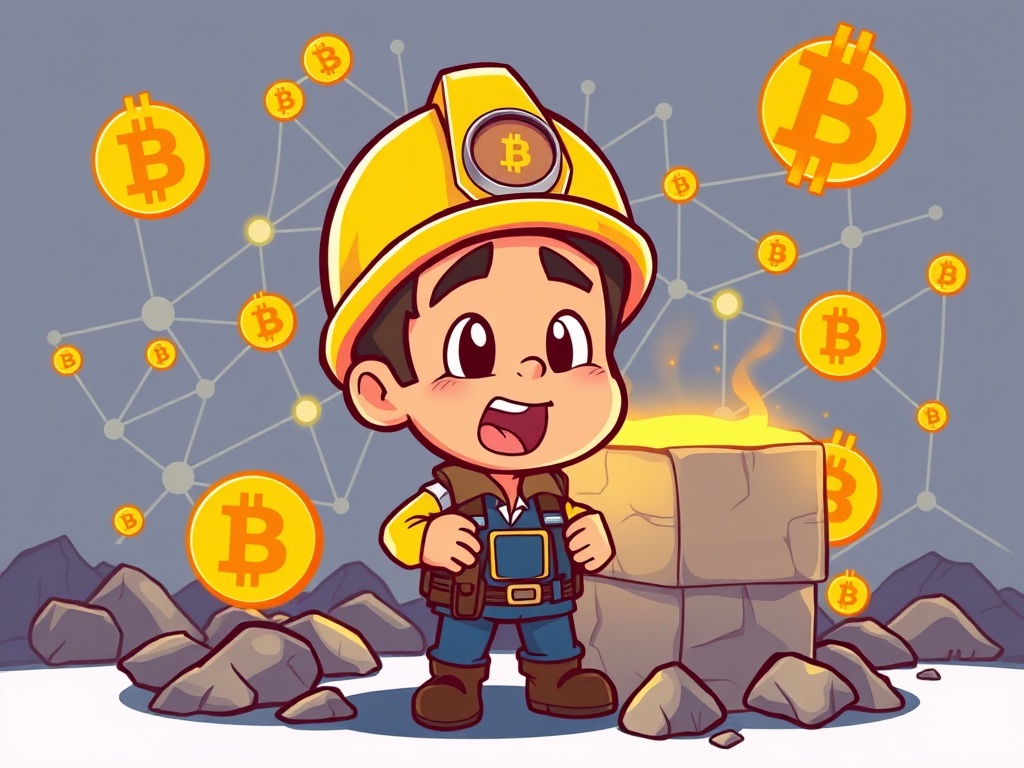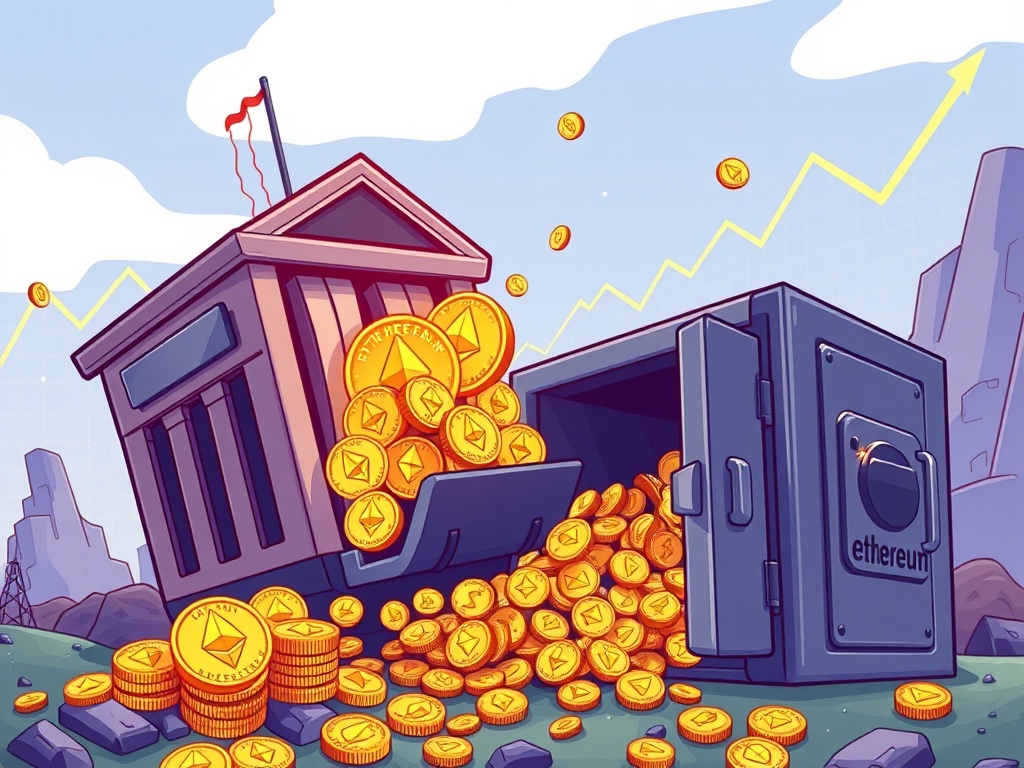BitcoinWorld

Solo Bitcoin Mining Miracle: Miner Strikes Gold with 3.16 BTC Block Reward
Imagine hitting the jackpot against astronomical odds, not in a lottery, but in the digital realm of cryptocurrency. This is precisely what happened recently when a dedicated individual achieved the near-impossible: a solo miner successfully mined a Bitcoin (BTC) block, securing a staggering 3.16 BTC. This extraordinary feat, recorded at block height 907,465 on July 28, according to blockchain explorer Mempool, resulted in a reward valued at approximately $377,500. It’s a moment that highlights the sheer unpredictability and immense potential rewards within the world of Solo Bitcoin Mining, inspiring countless enthusiasts and demonstrating that sometimes, against all odds, a single miner can indeed strike digital gold.
What Exactly is Solo Bitcoin Mining?
In the vast and competitive landscape of cryptocurrency, Solo Bitcoin Mining stands out as a high-stakes endeavor. Unlike most miners who join large mining pools to combine their computational power and share rewards, a solo miner operates independently. This means they dedicate their entire hash rate – the total computational power used to mine – to finding a block on their own. If successful, they keep the entire block reward, which currently includes the block subsidy (6.25 BTC, though this particular miner received a smaller amount due to transaction fees being part of the 3.16 BTC total reward) plus any transaction fees associated with the block.
The concept is simple: you’re trying to solve a complex cryptographic puzzle before anyone else in the world. The reality, however, is anything but. The difficulty of mining Bitcoin blocks adjusts roughly every two weeks, ensuring that new blocks are found approximately every 10 minutes. As more miners join the network, the difficulty increases, making it exponentially harder for any single entity to find a block.
How Does Bitcoin Mining Work and Why is it So Difficult?
At its core, Bitcoin mining is the process of adding new transactions to the Bitcoin blockchain. Miners use powerful computers to solve a complex computational puzzle, which is essentially finding a hash (a string of numbers and letters) that is less than or equal to a target set by the network. This process is known as Proof-of-Work (PoW). Here’s a simplified breakdown:
- Transaction Verification: Miners gather unconfirmed transactions into a block.
- Puzzle Solving: They then try to find a ‘nonce’ (a number used only once) that, when combined with the block’s data and hashed, produces a result below the network’s target difficulty.
- Block Discovery: The first miner to find this nonce broadcasts their solution to the network.
- Reward: If other nodes verify the solution, the block is added to the blockchain, and the successful miner receives the block reward (newly minted BTC) and transaction fees.
The difficulty is immense because the network’s total hash rate is colossal. Global Bitcoin mining operations utilize specialized hardware called ASICs (Application-Specific Integrated Circuits) that perform trillions of calculations per second. For a solo miner, their individual hash rate is a minuscule fraction of the global total, making the probability of finding a block akin to winning a lottery where there are billions of tickets, and you only hold one.
What are the Astronomical Odds Against a Solo Bitcoin Miner?
The odds of a solo miner finding a block are incredibly slim, often described as lottery-like. To put it into perspective, consider the current network hash rate, which can be in the exahashes per second (EH/s). A single, high-end ASIC miner might contribute a few hundred terahashes per second (TH/s). An exahash is 1,000,000 terahashes. This means one miner’s contribution is a tiny drop in a massive ocean of computational power.
The probability of a miner finding a block is directly proportional to their share of the total network hash rate. If a solo miner possesses, say, 0.0000001% of the total network hash rate, their chance of finding the next block is also 0.0000001%. This is why the news of a solo miner succeeding generates such buzz – it’s a testament to incredible luck and persistence, highlighting the rare success stories in Solo Bitcoin Mining.
Why Do Miners Still Attempt Solo Bitcoin Mining?
Given the overwhelming odds, one might wonder why anyone would even bother with Solo Bitcoin Mining. The answer lies in the allure of the full block reward. While joining a mining pool offers more consistent, albeit smaller, payouts, a solo miner stands to gain the entire bounty. For this particular miner, that meant a reward of 3.16 BTC, which at the time was valued at a significant $377,500. This lump sum can be life-changing, whereas pooled mining typically distributes fractions of BTC daily or weekly.
Beyond the financial incentive, some solo miners are driven by ideological reasons. They believe in the true decentralization of Bitcoin and prefer not to contribute to the concentration of hash power in large pools. By mining solo, they contribute directly to the network’s security and decentralization without intermediaries.
Challenges and Risks of Solo Bitcoin Mining
While the rewards can be massive, the challenges and risks associated with Solo Bitcoin Mining are equally substantial:
- High Upfront Costs: Acquiring powerful ASIC miners requires a significant initial investment.
- Electricity Consumption: Mining hardware consumes enormous amounts of electricity, leading to high operational costs that can quickly outweigh potential earnings if no block is found.
- Heat and Noise: Miners generate considerable heat and noise, requiring proper cooling and ventilation systems.
- Low Probability of Success: As discussed, the chances of finding a block are extremely low for individual miners, meaning extended periods (potentially years) with no payout.
- Hardware Failure: Constant operation can lead to hardware wear and tear or failure, requiring repairs or replacements.
- Market Volatility: The value of Bitcoin can fluctuate wildly, impacting the real-world value of any potential block reward.
Many aspiring solo miners often give up due to these challenges, making the recent success story even more remarkable.
The Unforgettable Solo Bitcoin Mining Success Story
The miner in question, operating with an estimated hash rate of around 1 PH/s (petahash per second), managed to beat the odds that were literally one in a million. This particular event wasn’t an isolated incident, though it remains incredibly rare. Over the years, there have been a handful of similar stories, often involving miners with surprisingly modest setups, which only adds to the mystique and appeal of Solo Bitcoin Mining.
Such events serve as powerful reminders of Bitcoin’s decentralized nature and the ‘permissionless’ aspect of its network. Anyone, anywhere, with the right equipment and a stroke of luck, can contribute to the network and potentially reap significant rewards. It’s a testament to the robust design of Bitcoin’s protocol that even with massive mining pools dominating the scene, individual efforts can still yield spectacular results.
What Does This Mean for the Future of Bitcoin Mining?
While this solo success story is inspiring, it doesn’t fundamentally change the economics or practicality of Bitcoin mining for the average individual. Mining pools will continue to be the dominant force, offering consistent, albeit smaller, returns. However, these rare events keep the dream alive for those who are willing to take on immense risk for the chance of an extraordinary payout. They also serve as a vital psychological boost for the Bitcoin community, reinforcing the idea that the network remains open and accessible, not just to large corporations, but to dedicated individuals as well.
It underscores Bitcoin’s resilience and its commitment to a system where participation is open to all, and success, however improbable, is always a possibility. This unique aspect ensures that the narrative of Bitcoin continues to be one of innovation, opportunity, and sometimes, pure digital serendipity.
Conclusion: The Enduring Allure of Solo Bitcoin Mining
The incredible achievement of a solo miner securing a 3.16 BTC block reward is more than just a news headline; it’s a powerful narrative about ambition, perseverance, and the sheer luck that sometimes plays a role in the high-stakes world of cryptocurrency. It serves as a vivid illustration of the ‘digital gold rush’ that Bitcoin mining represents, where immense computational power meets a lottery-like chance of success. While Solo Bitcoin Mining remains an endeavor with formidable challenges and extremely low probabilities, this story reminds us that against all odds, extraordinary feats are indeed possible. It fuels the dreams of countless individuals and reinforces the decentralized ethos at the heart of the Bitcoin network.
Frequently Asked Questions (FAQs) About Solo Bitcoin Mining
Here are some common questions about this fascinating aspect of the Bitcoin network:
Q1: Is Solo Bitcoin Mining profitable for most people?
A1: No, for most individuals, solo Bitcoin mining is highly unlikely to be profitable due to the extremely high network difficulty, significant hardware costs, and substantial electricity consumption. The chances of finding a block are astronomically low.
Q2: What is the main difference between solo mining and pooled mining?
A2: Solo mining involves an individual miner attempting to find a block entirely on their own, keeping the full reward if successful. Pooled mining involves many miners combining their computational power and sharing rewards proportionally to their contribution, leading to more consistent but smaller payouts.
Q3: How much Bitcoin does a miner get for finding a block?
A3: As of the most recent halving, the block subsidy is 6.25 BTC. Miners also receive transaction fees from all transactions included in the block. The 3.16 BTC in this story likely represents the total amount including transaction fees for that specific block.
Q4: What equipment is needed for Solo Bitcoin Mining?
A4: To even have a remote chance, you would need powerful Application-Specific Integrated Circuit (ASIC) miners, which are specifically designed for Bitcoin mining. These are expensive, consume a lot of electricity, and require proper cooling and ventilation.
Q5: Are there other cryptocurrencies that are easier to solo mine?
A5: Yes, some smaller or newer cryptocurrencies with lower network hash rates can be easier to solo mine. However, these often come with higher price volatility and lower potential rewards compared to Bitcoin.
Q6: How does this solo mining success impact Bitcoin’s security?
A6: Each successful block mined, whether by a solo miner or a pool, adds to the security of the Bitcoin network by verifying transactions and extending the blockchain. Solo successes like this highlight the decentralized nature and robustness of the network.
Share this incredible story of a solo miner defying the odds! If this tale of digital fortune has inspired you, consider sharing it with your friends, family, and fellow crypto enthusiasts on social media. Let’s spread the word about the amazing possibilities (and extreme challenges) of Solo Bitcoin Mining!
To learn more about the latest explore our article on key developments shaping Bitcoin’s institutional adoption.
This post Solo Bitcoin Mining Miracle: Miner Strikes Gold with 3.16 BTC Block Reward first appeared on BitcoinWorld and is written by Editorial Team





